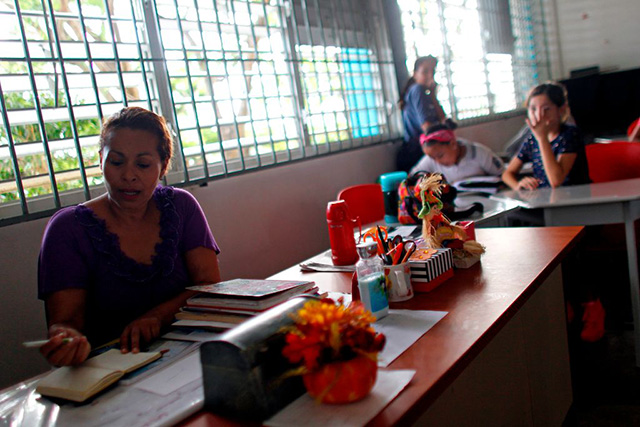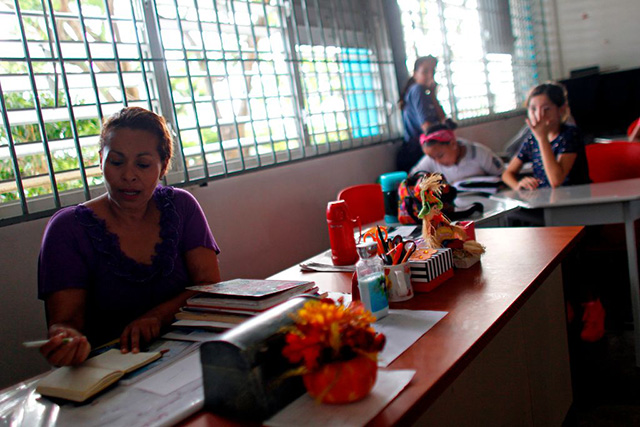
Did you know that Truthout is a nonprofit and independently funded by readers like you? If you value what we do, please support our work with a donation.
 Joan Rodriguez teaches English class to her 6th grade students at the Sotero Figueroa Elementary School in San Juan, Puerto Rico, November 6, 2017. The school reopened its doors without electricity to receive students 46 days after Hurricane Maria hit the island. (Photo: RICARDO ARDUENGO/AFP/Getty Images)
Joan Rodriguez teaches English class to her 6th grade students at the Sotero Figueroa Elementary School in San Juan, Puerto Rico, November 6, 2017. The school reopened its doors without electricity to receive students 46 days after Hurricane Maria hit the island. (Photo: RICARDO ARDUENGO/AFP/Getty Images)When Nilda Sánchez and her children ventured outside after Hurricane Maria waged a direct hit on Puerto Rico, aluminum road signs were crumpled by the highway near their house and trees crisscrossed each other like slain animals in the street. The power and water were off, and remained so for six weeks. It was nearly three months before Sánchez learned whether another of the mainstays in her family’s life would be restored: her son’s education.
Sebastián, Sánchez’s 9-year-old son, had been receiving therapy for his learning disabilities at Instituto Loaiza Cordero, a public school in their San Juan neighborhood. Already the school had been shut down following Hurricane Irma’s sweeping of the island Sept. 6. For the next three months, Sánchez had no word on how much damage the school had sustained in the storms, and no inkling of whether or when it would reopen.
Their hardships multiplied. Sánchez began to worry that Sebastián, who suffers from developmental delays in hand-eye coordination and attention deficit hyperactivity disorder, was regressing without therapy and the routine of school. Child support payments from Sánchez’s ex-husband — whom she left, she said, after he became abusive toward her — stopped coming, slipping through the cracks of administrative upheaval. Without anywhere else to be, Sebastián had to accompany Sánchez to the few job interviews she could find in the hurricane’s wake.
Sánchez says Hurricane Maria opened her eyes to the “cruelty” of living in bureaucratic limbo.
On Dec. 4, three months after Irma shut down Instituto Loaiza Cordero, and after its reopening was twice scheduled then postponed, a handful of students trickled through the front door at the morning bell. Sebastián, who Sánchez says had taken to sleeping in his school uniform, excitedly wheeled his backpack through the schoolyard.
Public schools in Puerto Rico began reopening roughly three weeks after Hurricane Maria, according to the island’s Department of Education (DOE), and 97 percent of island’s approximate 1,100 schools were open by the first week of December. The reopenings come after a protracted battle that pitted union leaders, parents and teachers against the DOE, led by Secretary of Education Julia Keleher, whom activists accuse of trying to render the temporary school closures necessitated by Maria permanent. Officials stalled in order to drive down enrollment and continue a trend of public school shutdowns on the island, say the critics who allege the ultimate goal was to privatize the $3 billion per year public education system.
Privatization is ultimately a matter for the island’s leadership to determine, but Keleher and the DOE appeared to be attempting to make the decision easier for them. “[W]e should not underestimate the damage or the opportunity to create new, better schools,” Keleher wrote on Twitter on Oct. 26, using Katrina “as a point of reference.”
New Orleans fired the entirety of its unionized classroom workforce following the 2005 hurricane. Teachers were forced to reapply for their jobs at the private, decentralized charter schools that replaced the city’s public schools. Many were not rehired. Only five traditional public schools remain today, and while student test scores have improved, critics say that is because charters persistently drop students with special needs from their rolls in order to bolster testing data and secure funding.
Sharing info on Katrina as a point of reference; we should not underestimate the damage or the opportunity to create new, better schools pic.twitter.com/Fmq59W4pKF
— Julia Keleher (@SecEducacionPR) October 27, 2017
In Puerto Rico, however, a campaign of popular resistance that grew in the path of Hurricane Maria’s destruction has so far been able to deter possible school closures, at least for the time being.
“At the beginning, the DOE didn’t want to open the schools,” says Rafael Feliciano Hernández, a former president of the Puerto Rican Federation of Teachers. “They wanted to close the schools for four months then to reopen them as charters. We fought. We joined forces with the community.”
Dozens of protests have been staged in the months since the storm, involving hundreds of parents, students, teachers and other advocates. Jinnette Morales Díaz, the mother of a 12-year-old child with Down syndrome and other disabilities whose school in the municipality of Guaynabo was closed for more than 50 days after Hurricane Maria, went on hunger strike outside the DOE’s San Juan headquarters on Nov. 2. Just hours into her hunger strike, the DOE announced her daughter’s school would reopen. Five days later, 19 people were arrested during a sit-in organized by the Puerto Rican Federation of Teachers at DOE headquarters.
Sec. Keleher, who until January 2016 worked as a management consultant in Washington, D.C., denied intentionally keeping schools closed, telling The Indypendent that each school building had to be inspected by the U.S. Army Corps of Engineers (USACE) before it could welcome students back. Keleher said she was “personally informed” of schools with active mold and missing roofs. “They were, by everyone’s estimation, unsafe conditions.”
The Corps has publicly refuted Keleher’s claim that it was keeping schools closed, and advocates contend that many of the schools that were shuttered for months after the hurricane sustained little or no damage in the storm. Some even had power and water where the communities surrounding them did not. “They tried to [institute a] neoliberal agenda using the U.S. Corps of Engineers to justify the lack of response to our communities,” said Edwin Morales, vice president of the teachers federation. “That that was a lie.”
An important factor in Puerto Rico’s education battle is the island’s massive debt crisis. The territory is saddled with $74 billion in public debt and the island’s Fiscal Control Board — instituted by Congress in 2016 to supervise a debt restructuring — imposed budget cuts across several departments, including the DOE, which represents nearly one-third of Puerto Rico’s $9 billion annual budget. Even before the debt crisis, public education shouldered cutbacks. The DOE closed 150 schools between 2010 and 2015. Then, in May, the DOE announced it would close 179 more, estimating it would save about $7 million per year on water and electric costs at the schools. The DOE is using the fiscal crisis “to justify budget cuts and make rightsizing measures” that especially impact poor children, said Morales.
In 2016, the U.S. Census Bureau estimated that over 40 percent of Puerto Rico residents were living below the poverty level. Closing and consolidating schools leaves poor Puerto Ricans with limited educational options.
Kelvin Coffie, whose 11-year-old son has autism, says Puerto Rico’s 120,000 plus disabled students suffer disproportionately from school closings since they require special services and have a more difficult time adapting to new school settings. His son’s school is still closed despite having sustained no major structural damage in the hurricane. Coffie said none of the other schools in his district are equipped to serve students with disabilities. “If they don’t open the school, I don’t know where I’m going to put my son,” he said.
Additionally, advocates continue to worry a mass exodus of students to the United States will lead to future school closures and disenfranchise the families who remain.
When asked how many schools will eventually close in the aftermath of Maria, Keleher said she would have to wait until January to tabulate what “our population looks like, because the dust hasn’t settled yet.” She said her October tweet was “referring strictly to the physical conditions” of schools in New Orleans post-Katrina. “I have not opined on the issue [of privatization]. I have done nothing and I have said nothing,” she said, adding that she is “going to look and fight for every resource and every dollar that I can bring to the island.”
At Instituto Loaiza Cordero, two weeks after reopening, many students are absent. Nilda Sánchez fears her son’s classmates will never return. “Some are out of Puerto Rico,” she explains. “Some of them cannot go to the school or do not know that the school is open.”
Monica Espitia contributed to this article.
The newspaper Naomi Klein calls “utterly unique,” full of insightful dispatches from around the world, The Indypendent offers a fresh take on today’s events.
Press freedom is under attack
As Trump cracks down on political speech, independent media is increasingly necessary.
Truthout produces reporting you won’t see in the mainstream: journalism from the frontlines of global conflict, interviews with grassroots movement leaders, high-quality legal analysis and more.
Our work is possible thanks to reader support. Help Truthout catalyze change and social justice — make a tax-deductible monthly or one-time donation today.